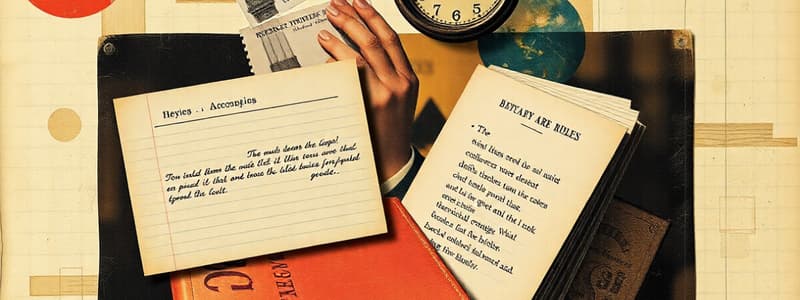Podcast
Questions and Answers
The total of the purchase Day book is posted periodically to the:
The total of the purchase Day book is posted periodically to the:
- Debit of supplier a/c
- Debit of purchases a/c (correct)
- Cash book
- Credit of purchases a/c
Total of the sales book for March indicates:
Total of the sales book for March indicates:
- Total sales less sales return
- Total sales for the month
- Total cash sales for the month
- Total credit sales for the month (correct)
Purchases book is used to record:
Purchases book is used to record:
- All credit purchases
- All credit purchases of assets
- All purchases of goods
- All credit purchases of goods (correct)
The source document or voucher used for recording entries in sales book is:
The source document or voucher used for recording entries in sales book is:
The debit note issued are used to prepare
The debit note issued are used to prepare
Purchased goods from E worth Rs. 5,000 on credit basis
Purchased goods from E worth Rs. 5,000 on credit basis
Unpaid salary is to be provided for in the accounts
Unpaid salary is to be provided for in the accounts
The Sales returns book records
The Sales returns book records
The sales book is
The sales book is
The balance of Petty cash is:
The balance of Petty cash is:
Cash book is a form of:
Cash book is a form of:
Double entry in cash book is completed when:
Double entry in cash book is completed when:
Salaries due for the month of march will appear
Salaries due for the month of march will appear
Flashcards
Purchase Day Book total posting
Purchase Day Book total posting
The total from the purchase day book is periodically posted to the debit of the purchases account.
Sales Book total (March)
Sales Book total (March)
The total of the sales book for March represents the total sales for the month.
Purchases Book
Purchases Book
Records all credit purchases of goods.
Sales Book source document
Sales Book source document
Signup and view all the flashcards
Debit Note use
Debit Note use
Signup and view all the flashcards
Record purchase from E (Rs. 5,000)
Record purchase from E (Rs. 5,000)
Signup and view all the flashcards
Unpaid Salary
Unpaid Salary
Signup and view all the flashcards
Sales Returns Book
Sales Returns Book
Signup and view all the flashcards
Sales book nature
Sales book nature
Signup and view all the flashcards
Petty Cash balance
Petty Cash balance
Signup and view all the flashcards
Cash Book nature
Cash Book nature
Signup and view all the flashcards
Double-entry cash book completion
Double-entry cash book completion
Signup and view all the flashcards
March salaries in cash book
March salaries in cash book
Signup and view all the flashcards
Cash Book scope
Cash Book scope
Signup and view all the flashcards
Cash column balance
Cash column balance
Signup and view all the flashcards
Cash discount application
Cash discount application
Signup and view all the flashcards
Petty Cash Book type
Petty Cash Book type
Signup and view all the flashcards
Cash Book Accounting Rule
Cash Book Accounting Rule
Signup and view all the flashcards
Trial Balance preparation methods
Trial Balance preparation methods
Signup and view all the flashcards
Customer goods return document
Customer goods return document
Signup and view all the flashcards
Study Notes
Level - I (K1)
- The total of the purchase day book is periodically posted to the debit of the purchases account.
- The total of the sales book for March indicates the total sales for the month.
- A purchase book records all credit purchases of goods.
- The invoice sent out is the source document used in the sales book.
- Debit notes are used to prepare purchase return books.
- Purchased goods worth Rs. 5,000 on credit are recorded in the Purchases book.
- Unpaid salaries are provided for in the accounts.
- Sales return books record the return of goods sold.
Level - II (K2)
- A debit note is sent to a customer when he/she returns goods.
- Purchase of fixed assets on credit is recorded in the Journal Proper.
- Trade discounts are not recorded in the books.
- The total of sales book is posted in the credit side of the Sales Account.
- A note sent by a buyer on return of goods is a credit note.
- Purchase of furniture on credit is recorded in the Purchase book.
- An allowance of Rs.50 for early payment of Rs. 1,050 is recorded in the Cash book.
- A second-hand motor car purchased on credit is recorded in the Journal Proper.
Level - III (K3)
- Goods sold for cash (Rs. 10,000) plus 10% sales tax are credited by Rs. 11,000 in the sales account.
- The balance of the sales day book is Rs. 25,000, and Rs. 5,000 was recovered from debtors; the remaining balance of Rs. 20,000 is transferred.
- If debit and credit aspects of a transaction are recorded in the cash book, it's a double entry.
- Cheques received but deposited the next day are recorded in the Bank column of the cash book.
- Re-imbursement for petty cash expenses (telephone Rs. 150, tiffin Rs. 50, repairs Rs. 30, general expenses Rs. 100) is Rs. 300.
- Interest received of Rs. 100 recorded as interest paid reduces the cash balance by Rs. 100.
- The difference of the total debit and credit sides of the trial balance is transferred to the Miscellaneous account.
- A machine purchased on 1 April 2007 for Rs. 5,00,000 and another on 1 October 2007 for Rs. 2,00,000, with depreciation @20% p.a. on written down value, has depreciation of Rs. 1,20,000 for the year ending 31 March 2008.
- The original cost of a machine rs.1,50,000, estimated life 5 years and expected salvage value Rs. 3,000, has a depreciation rate of 19.6% per annum.
- Salman and Usman Bros. acquired a machine on 1 July 2014 at a cost of Rs. 70,000 and installation cost Rs.5,000; @ 10% on straight-line method depreciation, the net value at the end of the second year is Rs 63,750.
Unit 4 - Depreciation
- Depreciation starts on a machine from the date it's put to use.
- Depletion method of depreciation is applied to wasting assets.
- Depreciation is charged on the written down value in reducing balance method.
- The main objective of depreciation is to reduce tax.
- Depreciation is due to wear and tear.
- Salvage value is the definite sale price of the asset.
- Depreciation is calculated under the diminishing balance method based on the book value.
- Becoming out of date is known as obsolescence.
- Depreciation is the decrease in the value of an asset over time due to wear and tear or obsolescence.
- Depreciation is normally calculated using the straight-line method.
- Depreciation, in accounting, is the allocation of an asset's cost over its useful life.
Unit 5 - Final Accounts
- The primary purpose of Final Accounts is to communicate financial information.
- The profit and loss account is also known as the income statement.
- Concerning adjustments for accrued expenses, the adjustments increase liabilities.
- The trading account shows the gross profit or loss on trading activities.
- The profit and loss account reflects the financial performance for a given period.
- The balance sheet contains assets and liabilities.
- Adjustments in Final Accounts ensure accurate financial reporting.
- Goodwill, an intangible asset, is represented on the Balance Sheet.
- Wages and salaries are shown on the debit side of the profit and loss account.
- Returns outwards are shown on the credit side of trading account.
- Closing stock appearing in the trial balance is a credit/debit entry in trading account.
- Manufacturing account includes all direct and indirect expenses.
- Manufacturing accounts are prepared by manufacturing organisations, The manufacturing accounts are prepared by manufacturing organizations.
- A long-term liability on the balance sheet is Bank Loan.
- Adjustments in final accounts are used to correct any errors and reflect financial position/ enhance tax liabilities.
- The Trading Account calculates the cost of goods sold.
- Cost of goods sold is a key component of the Trading Account, which includes related direct selling expenses.
- Recording a sale on credit is an example of an adjusting entry.
- Accruals refer to revenues earned but not yet received, or expenses paid in advance.
Studying That Suits You
Use AI to generate personalized quizzes and flashcards to suit your learning preferences.





